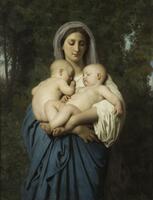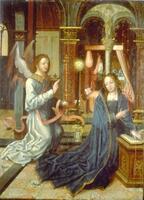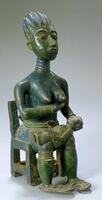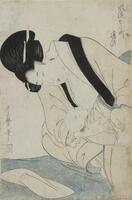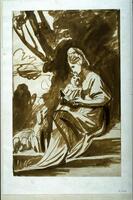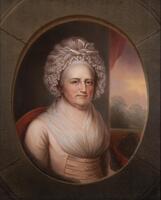Barbara Hepworth - Sphere with colour (Grey and white).
Much of Hepworth’s sculptural work is white, or sometimes black or bronze. She also made some work of hard Nigerian guaranteed wood, which was sent to her by a friend. Her work often has the theme of pregnancy or childbirth, including abstract figures with a rounded, womb-like hole. The idea of “pierced” shapes was taken up by other sculptors at the time, notably Henry Moore. Hepworth had a son by her first marriage, and subsequently triplets when married to the artist Ben Nicholson.
This sculpture, unlike Hepworth’s mainly white sculptures, is carved from striped green marble. The indents, when viewed at a distance (at least 6 ft with one eye closed is best) as you walk around, appear to be floating above the surface, like moons orbiting a planet.
1964, the year before this sculpture is officially dated, was the 4th centenary of Galileo’s birth. He is famous for his use of the new technology of the telescope in observing Jupiter’s moons, Io, Europa, Ganymede, and Callisto. Hepworth had Italian friends, who could easily have written to her with letters bearing the contemporary postage stamps commemorating Galileo. Magazine articles were published at the time about new observations of Jupiter, which would have been easily visible shining brightly in the night sky from her studio in St Ives, overlooking the Atlantic Ocean.
However, Sphere with colour (Grey and White) has only three moon-like indents, whereas Jupiter has four main moons, as discovered by Galileo. Returning to Hepworth’s more common theme of pregnancy and motherhood, the question arises again, why only three indents?
Hepworth had four children; three were triplets. Could this refer to the triplets? Or could it be telling us about her oldest son Peter, an RAF pilot who was killed in a plane crash in Thailand ten years earlier (1953)? Mourning her son, she may have felt like a planet missing its moon.
9 Items in this Learning Collection
Copyright
Shrine Figure
2006/2.72
Title
Shrine Figure
Artist(s)
Akpojivi of Orhokpokpo
Object Creation Date
1900-1950
Medium & Support
wood and pigment
Dimensions
72 ½ in x 17 in x 16 in (184.15 cm x 43.18 cm x 40.64 cm);11 4/5 in x 15 3/16 in x 15 3/16 in (30 cm x 38.58 cm x 38.58 cm);60 11/16 in x 17 in x 16 in (154.15 cm x 43.18 cm x 40.64 cm)
Credit Line
Gift of Robert and Lillian Montalto Bohlen
Label copy
March 28, 2009
This figure represents Ohahe, the spirit of the silk cotton tree, and her countenance manifests a recurring tension in Urhobo aesthetics: she is “fearsome to mortals, yet beautiful to the spirits.” Scarification patterns identify her lineage, while her tufted coiffure resembles those of high-ranking women. Her head and face were sculpted by the master carver Akpojivi, while an apprentice carved the rest of the figure—a common practice among Urhobo master artists.
The Urhobo carved figures like this to commemorate the edjo, spiritual forces that pervade the natural world and embody a community’s founding ancestors. Every Urhobo community had its own edjo installed in a small and darkened shrine house maintained by the town’s spiritual leaders. A life-sized example of such statuary is extremely rare in African art.
Subject matter
The Urhobo carved life-sized figures to commemorate the edjo – spiritual forces that pervade the natural world and embody a community’s founding ancestors. Every Urhobo community had its own edjo installed in a small shrine house that was maintained by the town’s spiritual leaders. These shrine houses were darkened to keep the figure hidden from view for all but a few days a year, when large festivals were organized in its honor. Shrine figures could be installed in pairs of male and female, which together manifested the martial power and fecundity of the spirits. These figures embody a classic tension in Urhobo aesthetics – they are fearsome to humans, but beautiful to the spirits.
Physical Description
Life-sized seated female figure holding a child. Face has rounded, high forehead, ovoid eyes, flat, rectangular nose and protruding, open ovoid mouth. Pigmented, bilateral scarification patterns of forehead, temples and jowls, at back of neck. Scarification also on upper arms and breast. Pigmented coiffure is elaborate with triangular and dome-like shapes. Necklace and hoop-like ring carved in relief onto neck and shoulders; figure has protruding navel, wears anklets and armlet at elbow, and holds a baby suckling at left breast.
Primary Object Classification
Sculpture
Primary Object Type
figure
Collection Area
African
Rights
If you are interested in using an image for a publication, please visit http://umma.umich.edu/request-image for more information and to fill out the online Image Rights and Reproductions Request Form.
Keywords
beauty
figures (representations)
shrines (structures)
spirits (beings)
